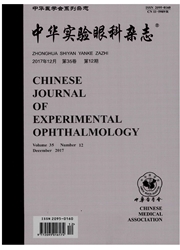

 中文摘要:
中文摘要:
背景研究证明,缺血后适应(IPC)对多种组织器官的缺血缺氧损伤均有一定的抵抗作用,但其对视网膜缺血缺氧的作用仍受到关注。目的探讨IPC对大鼠视网膜缺血-再灌注损伤(RIRI)后视网膜结构和功能的保护作用。方法将36只健康雄性Wistar大鼠以随机数字表法分为正常对照组、伪手术组、缺血-再灌注组、IPC组。利用前房灌注生理盐水升高眼压至100mmHg(1mmHg=0.133kPa)维持60min的方法制备RIRI大鼠模型,实施IPC处理鼠亚分为再灌注后即刻、1min、10min组(即IPCⅠ组、IPCⅡ组、IPCⅢ组),分别于实验后1d、7d行大鼠视网膜电图(ERG)检测,然后用过量麻醉法处死大鼠并制备视网膜切片,行苏木精-伊红染色,对各组大鼠视网膜厚度的变化和视网膜形态进行观察。采用SPSS13.0统计学软件的单因素方差分析对各组大鼠ERG各波振幅恢复率和视网膜厚度值的差异进行比较。结果实验后1d,与正常对照组大鼠比较,伪手术组大鼠视网膜结构接近正常,而缺血-再灌注组及IPCⅠ组、IPCⅡ组、IPCⅢ组大鼠视网膜均出现水肿,可见空泡变性,主要在内丛状层(IPL)及内核层(INL)。缺血-再灌注组及IPCⅠ组、IPCⅡ组、IPCⅢ组大鼠视网膜全层、INL、IPL及视网膜外层厚度值均明显高于正常对照组,差异均有统计学意义(均P〈0.05)。再灌注后7d,缺血-再灌注组大鼠视网膜全层厚度值明显低于正常对照组,差异均有统计学意义(均P〈0.05),尤以INL、IPL显著。IPCⅠ组、IPCⅡ组、IPCⅢ组大鼠视网膜全层、INL、IPL及视网膜外层厚度值均明显高于缺血-再灌注组,差异均有统计学意义(均P〈0.05)。再灌注后7d,缺血-再灌注组、IPC各组大鼠ERG a波、b波和OPs振幅恢复率明显低于伪手术组和正常对照组大鼠,差异均有统计学意义(均P〈0.05);而IPCⅠ组、IPCⅡ组、IPCⅢ组?
 英文摘要:
英文摘要:
Background The potential protective effect of ischemia postconditioning for hypoxia has been determined in many tissues and organs. But its mechanism in retina is still lack. Objective The aim of this study was to investigate the protective effect of ischemia posteonditioning on retinal isehemia reperfusion injury. Methods Thirty-six health male Wistar rats were randomized into the normal control group, sham group,ischemia reperfusion group and ischemic postconditioning group. Retinal ischemia reperfusion models were induced by elevating the intraocular pressure to 110 mmHg for 60 minutes,and then the ischemic postconditioning was performed right away, 1 minute and 10 minutes after ischemia in the rats of the ischemic postconditioning Ⅰ,Ⅱ,Ⅲ group, respectively. Electroretinogram (ERG) was recorded in the rats 7 days after operation,and the rats were sacrificed by excessive anesthesia. Retinal specimens were prepared for the histopathological examination. The retinal thickness and the recovery rates of ERG a,b waves and oscillation potentials (OPs) were compared among the groups using ANOVA of SPSS software. Results One day after experiment,the structure of rat retinas was nearly normal. However,retinal edema and vacuolar degeneration were seen in the rats of the ischemia reperfusion group and ischemic postconditioning Ⅰ,Ⅱ,Ⅲ groups primarily in the inner plexiform layer (IPL) , inner nuclear layer (INL). The retinal thickness values of the entire layer, IPL and INL were significantly higher in the ischemia reperfusion group and ischemic postconditioning Ⅰ,Ⅱ,Ⅲ groups compared with the normal control group (all at P 〈 0.05 ). Seven days after experiment,the retinas were thinner in the rats of the ischemia reperfusion group than those of the rats in the sham group,but the retinal thickness values in the ischemic postconditioning Ⅰ,Ⅱ,Ⅲ groups were significantly increased in comparison with the ischemia reperfusion group (all at P〈0.05 ). In addition, the recovery rat
 同期刊论文项目
同期刊论文项目
 同项目期刊论文
同项目期刊论文
 期刊信息
期刊信息
